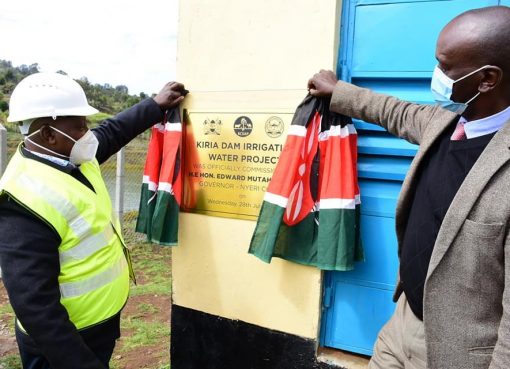The County Government of Nakuru has raised conservation concerns over increasing activities by hoteliers around Lake Elementaita.
A fact finding mission established that developers had encroached on the riparian land, while constructing new hotels and lodges posing a threat to over 400 species of birds, including flamingoes, pelicans and 13 other globally threatened bird species. The birds are very sensitive to environmental change.
The County Environment Chief Officer, Dr. Muriithi Kiogora said besides the developments, the water body was currently facing immense pressure due to pollution and encroachment.
At a stakeholders meeting attended by representatives from County departments of Trade and Tourism and Environment, the Kenya Wildlife Service (KWS) and the National Environment Management Authority (NEMA), Dr. Kiogora observed that degradation of the lake had adversely affected water quality, productivity and biodiversity. This, he added affected its ability to support life.
Of greater concern to the team is the fact that 75 percent of Lake Elementaita ecosystem is privately held as Soysambu Conservancy, a 45,000-acre wildlife and cattle ranch.
The Lake Elementaita Boundary Survey report drafted in 2016 under a project funded by KWS and United Nations Educational, Scientific and Cultural Organization (UNESCO) blamed the confusion on 1950 maps that did not put into consideration riparian land.
“Almost three quarters of the lake falls under a private land. We need to identify and map the riparian and boundaries around the lake. The county administration will focus more on environmental protection and conservation of the Lake’s ecosystem. We will partner with the national government and other stakeholders to develop and implement strict and clear regulations to prohibit developments in close proximity to the fragile habitat and in the critical buffer zone within the ecosystem,” affirmed the County Environment Chief Officer.
Elementaita is one of three water bodies that form the Kenya Lake System in the Great Rift Valley. The three lakes, including Nakuru and Bogoria are inter-linked and are relatively shallow.
The three lakes are on UNESCO’s World Heritage list of natural sites and are especially prized for their bird life. According to UNESCO the sites includes, the single most important foraging site for the lesser flamingo anywhere, with hundreds of thousands of lesser flamingos moving between the three lakes.
“Lake Elementaita is a vital breeding site for the great white pelicans, has over 450 species of birds and is a haven for thousands of greater and lesser flamingos that flock during favourable conditions.
It was designated as an Important Bird Area in 1999, a Ramsar site in 2005, a national wildlife sanctuary in 2010 and was inscribed as a World Heritage Site in 2011 by Unesco, together with Lake Nakuru and Lake Bogoria, as part of the Kenya Lakes System in the Great Rift Valley,” explained Dr. Kiogora.
Its basin, he added, has one of the oldest archaeological sites. It is of the Oldowan period with stone tools dating back to 700,000 years ago found at Kariandusi.
The Obsidian mines at the Eburru Mountains are evidence of Obsidian trade more than 3,000 years ago. The region was occupied by the pastoral Neolithic and later the Maasai who called it Elementaita.
The Trade and Tourism County Executive Committee Member, Raymond Komen said increased heavy metal content from solid waste was degrading the lake. “There has been an increase in organic pollution due to urbanization. We are committed to addressing toxic contaminants, encroachment and misuse of resources around the lake,” stated Komen.
He said that the county administration would address concerns raised over easy and free access to hot springs especially during weekends which cause damages, including water pollution and heavy littering.
“These human activities have negative effects on fish and birdlife. Individuals visiting warm baths and hot springs believed to have therapeutic benefits have polluted the water with phosphates and other soap ingredients,” stated Komen.
He asserted that the devolved unit will sustain garbage collection and engage in tree planting and community outreach programmes in conserving the water body. The devolved unit will also partner with stakeholders in exploring alternative remedial measures such as erecting fences around hot springs, providing alternative water collection points for the communities and establishing a Community Eco-education and Resource Centre for the people to learn conservation.
“There is need for public awareness campaigns as human activities and climate change is a threat to lakes and the species that live there. We will stress the need to protect the environment whilst investing more in conservation,” assured Komen.
He said saving the lake needed a multi-sectoral approach, bringing together the two levels of government, the National Environmental Management Authority and Water Resources Management Authority among others.
The County Trade Chief Officer, Hussein Mohamed said the devolved unit will work with all stakeholders in coming up with new strategies that will package Lake Elementaita as a tourism destination while ensuring removal of illegal developments and restoring affected areas.
“There exists a huge eco-tourism potential within Lake Elementaita and its catchment areas to promote environmental conservation and socio-economic development that involves community participation for poverty alleviation.
The area is of immense importance both nationally and internationally with tremendous potential for eco-tourism development. We are keen to exploit this advantage,” said Mohamed.
The Nakuru advocate, Richard Andayi suggested that to protect the lake there was need to harmonize laws that contradict each other on riparian distance, saying almost all the nine laws on riparian areas vary on distance.
“Lake Elementaita is a World Heritage Site protected by local and international laws, but the greatest challenge lies on who among the many agencies is supposed to manage it
Before any hotel or structure comes up, the National Environmental Management Authority (NEMA) should give a license and the Water Resource Management Authority (WARMA) should be consulted,” he says.
Andayi however, said he was aware that National Lands Commission (NLC) has since earmarked affected parcels on the lake that have been encroached and written to ‘invaders’ to vacate the land.
By Anne Mwale




